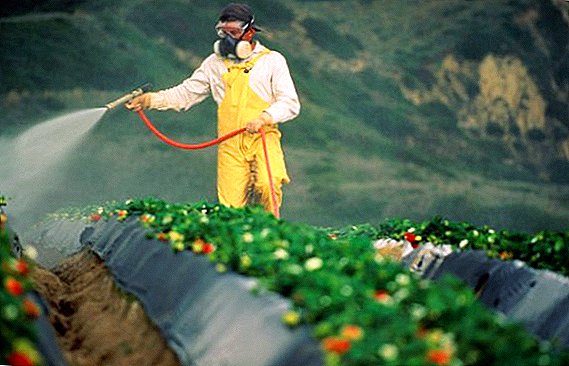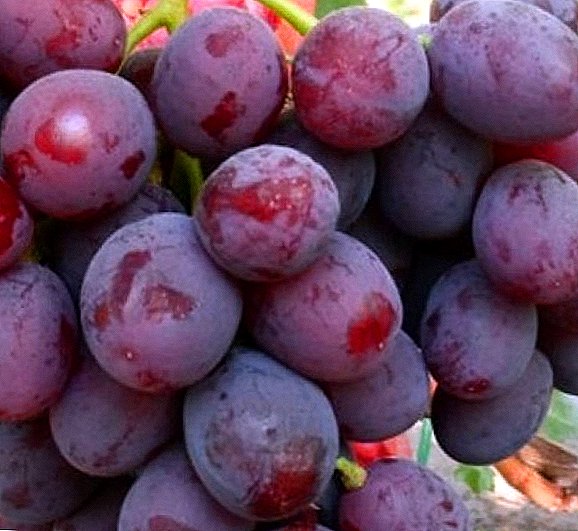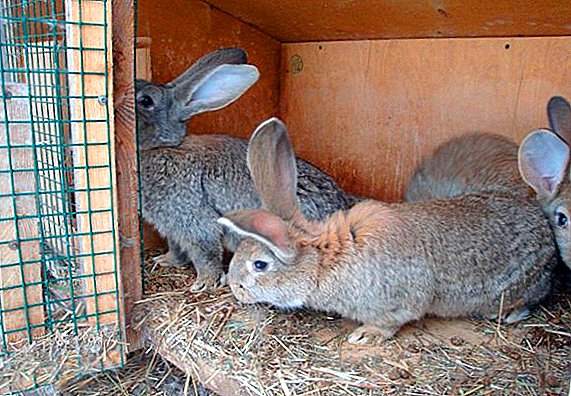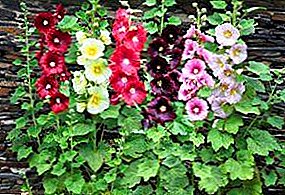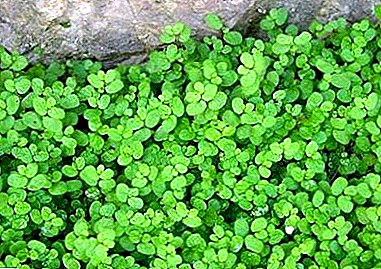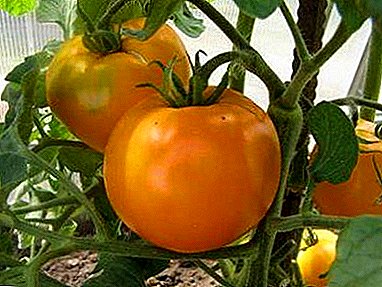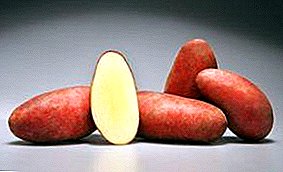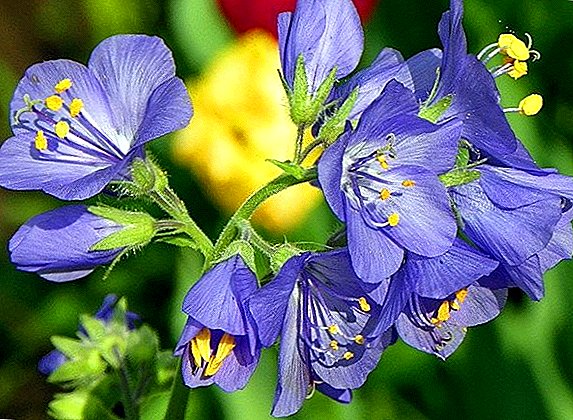 An amazing representative of the flora with the unusual name of cyanosis or the polemonium is rarely seen as an inhabitant of a home garden plot. This herbaceous plant from the Sinyukhov family includes about 40–50 species that are suitable for a temperate environment and the northern territories. It can be grown for two purposes: as a beautiful ornamental plant, and also as a healing medicine. Let us consider in more detail some of its varieties.
An amazing representative of the flora with the unusual name of cyanosis or the polemonium is rarely seen as an inhabitant of a home garden plot. This herbaceous plant from the Sinyukhov family includes about 40–50 species that are suitable for a temperate environment and the northern territories. It can be grown for two purposes: as a beautiful ornamental plant, and also as a healing medicine. Let us consider in more detail some of its varieties.
Blue or azure

Sinyuha blue (polemonium caeruleum)which is also called azure, is most common in Russia, Siberia, and also in western Europe. It features a single upright shoot and blue flowers with orange stamens.

The leaves have an interesting cut shape and a tapering at the ends, and the shrub itself develops in a height of 30 to 120 cm. Flowering is observed in June-July, the plant may also bloom a second time in late August or early September. Below you can see a photo of blue cyanus - beauties of heavenly color
Familiarize yourself with the cultivation of other plants that will decorate your site: welshkum, lofanta, wolf aconite, soapworm, gravilata, eremurus, acanthus, borage, mattiola, black cohosh, geyhery, zhiryanki, celesia, splendor, kamnelomki.
Brandegs

Brandegs are most common in the western states of the United States of America (from Wyoming to Colorado). More oblong, upwards flowers varying in color from white to pale golden color, - the main difference of this species from other representatives of its genus. Grown infrequently due to the difficulty in obtaining a base for planting.
California

Californian species range is the North American Sierra Nevada mountain range, which is probably why it was called so. Differs bell-shaped, blue color flowers. Propagated plant species with rhizomes, has no special difficulties in spreading in their native regions.
Did you know? In English-speaking countries, the cyanosis genus and many of its varieties are called "Jacob's Ladder." The name symbolizes a dream, once dreamed of the biblical Apostle Jacob about the steps connecting earth and heaven.
Sticky

The species is distributed in rocky hills and in the mountains of the United States, ranging from the east of Washington State to Arizona and New Mexico. In the first two summer months, blue flowers with yellow stamens can be seen on stems up to 15 cm in height with whitish leaves.
Beautiful

Sinyuha beautiful is a low-growing plant with a height of 10-25 cm, the stems are weakly branchy. Inflorescences have a complex shape (paniculture) and are located at the top of the stems. The area of this species of polmonium is the mountain slopes of Altai, Siberia.
Important! Polemonium is a moisture-loving representative of the flora, quietly related to low temperatures, not tolerating drought. Increased acidity of the soil is bad for the life of the plant. The optimal location for its cultivation is a sunny or semi-shaded lowland area with a shallow groundwater location.
Flax flower

A perennial plant, grows in deciduous forests, in river valleys, in forest meadows of Mongolia, Japan, China, Altai, eastern Siberia, and the Far East. On thin, erect stems 35-75 cm high, one can see odd-pinnate leaves and pale blue panicled inflorescences.
Small flowers

Homeland of this type of polnerium is the state of Arizona. In our area, growing as a perennial is impossible, since this type of plant is very thermophilic. On stems up to 40 cm in height, yellow flowers bloom, a distinctive feature of which is small blotches of orange color.
If you want to arrange a flower bed with blue flowers, you can plant anemone, brunner, asters, bells, delphinium, gladiolus, muscari, forget-me-not, petunia, phlox, lungwort, veronica, periwinkle.
Shaggy

Slender plant (40-65 cm) with erect multi-leaf stems, decorated with blue flowers with orange stamens. Distributed on the territory of the East Asian continent (Sakhalin, Kamchatka, Commander Islands, the Arctic, eastern Siberia). The flowers appear in the first half of summer, and the polymonium bears fruit in August.
Many-leaved

This species grows in height from 60 to 80 cm, and is distinguished by delicate lavender-blue flowers that bloom in summer. The plant grows well, if necessary tolerates drought.
Did you know? In folk medicine, the polémonium is called "blue valerian": it is very often taken as a sedative for insomnia, anxiety, and neurasthenia.
Ostropecia

Ostrolepodnoe polmonium can be found in Siberia, in the Far East, in the northern parts of Europe and America, where it develops beautifully along the banks of reservoirs, moss bogs, as well as in the mountain ranges of the Baikal region. On single upright shoots reaching a height of 30 cm, small flowers of blue color are conveniently located.
North

The area of this species is the Norwegian, Canadian and Siberian territories. The plant loves dry tundra, sandy banks of the rivers, sea pebble beaches, alpine meadows. This species grows low (15-20 cm), and slightly branched stems with basal leaves are distinguished by blue flowers with a violet shade.
Chartaseum

Chartaseum is dwarf plant, common in the highland meadows of northern California. The shrub begins to bloom earlier than other species (in March), but the flowers also fall by the beginning of summer. On short stalks (up to 8 cm in height), round inflorescences can be seen with flowers of a dark blue shade, which are located very close to the leaves of the dissected form.
Pretty

Alaska is the motherland of this species, although it is quite common in the western United States. Pretty Cyanus is quite changeable in the parameters of the height, which it can reach (from 8 to 20 cm). The color of the flowers varies from pale blue to purple.
Important! For medicinal purposes, rhizomes with plant roots are used. Cleaning is best done in late autumn or in the spring before the start of regrowth. You can use and fresh raw materials, and drying for the preparation of infusions and decoctions.The most accustomed form of polmonium on our continent is blue cyanosisthen we will look at the basic rules planting and care behind this plant:
- Landing site: sunny plot or light penumbra, protected from the wind (subject to this item, abundant flowering variegated cyanosis you provided.
- Soil: sandy and clay with the addition of compost and humus.
- Watering: frequent, should be high soil moisture, otherwise the plant will not bloom.
- Pruning: after flowering, all the inflorescences that have bloomed, pruned.
This wonderful representative of the flora plays the role of not only the inhabitant of the garden plot, but also a good folk healer. The healing properties of the plant manifest themselves as expectorant, sedative (sedative), anti-inflammatory effects on the human body in case of diseases of the respiratory system, increased nervous excitability, gastric ulcer, and infectious diseases.


